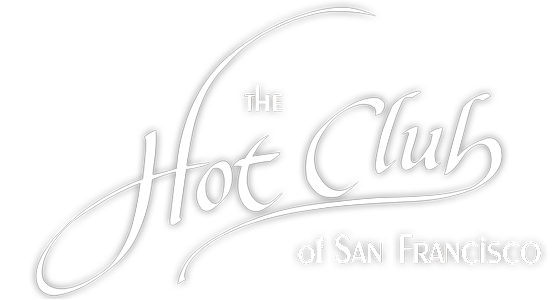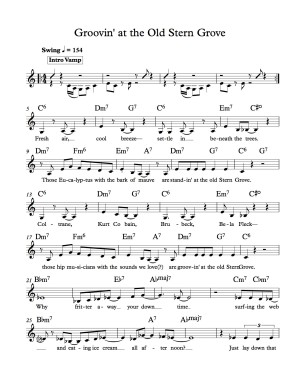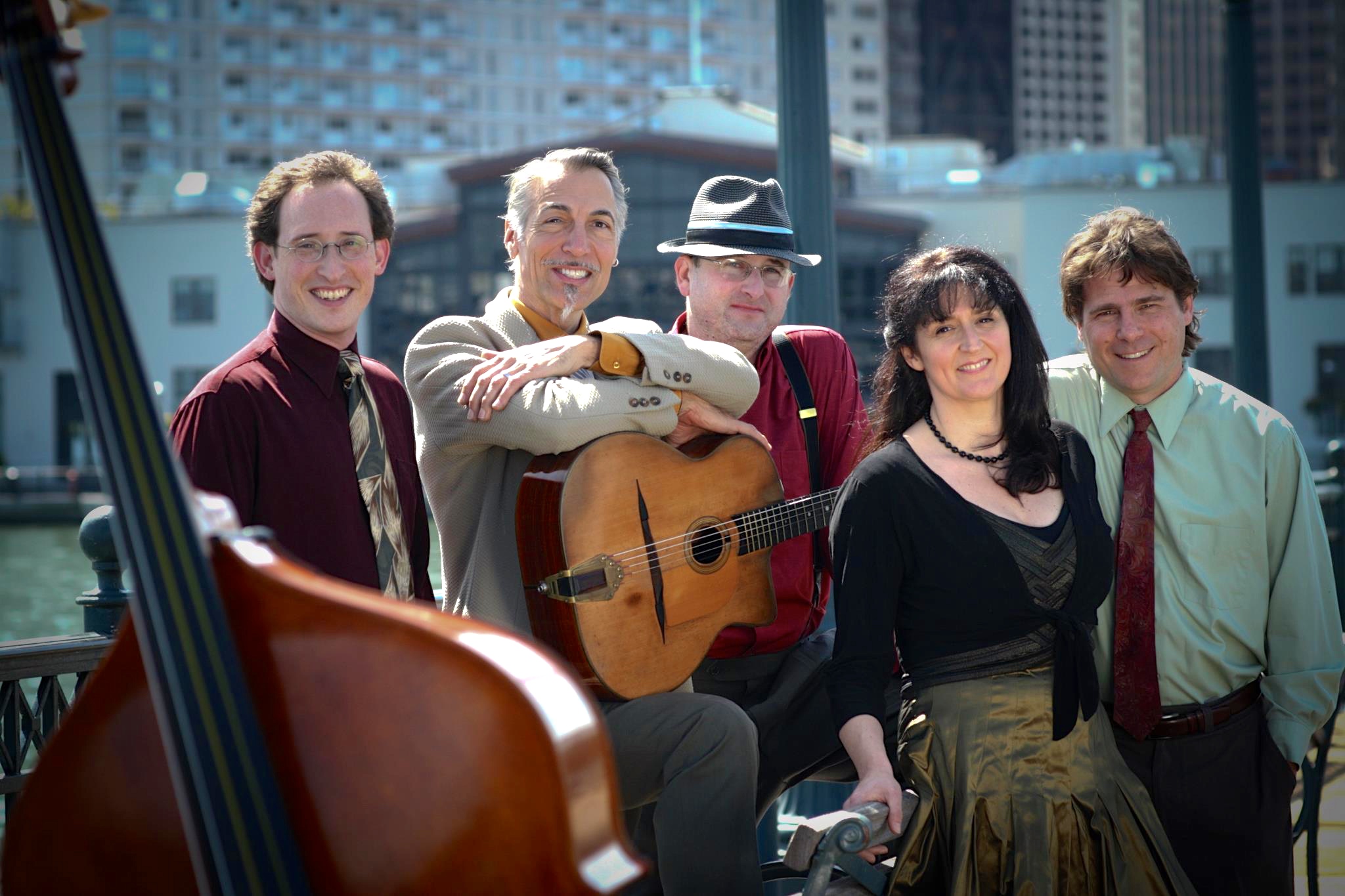THE HOT CLUB OF SF IS PROUD TO ANNOUNCE OUR 14TH CD "JOHN PAUL GEORGE & DJANGO" COMING SOON
It was only a matter of time before guitarist Paul Mehling focused his creative mojo on Lennon and McCartney’s vast and enduring treasure trove of songs. The founder and guiding spirit of the Hot Club of San Francisco, America’s longest running Gypsy swing ensemble, Mehling was first inspired to pick up a guitar when the Beatles launched the British Invasion via Ed Sullivan’s CBS variety show on Feb. 9, 1964. Now Mehling’s HCSF is recolonizing the Fab Four’s songbook in the name of Gypsy jazz legend Django Reinhardt with John, Paul, George and Django, a ravishing and consistently revelatory reimagining of classic Beatles tunes. Slated for release on Mehling’s Hot Club label in September, 2016, the band’s 14th album is designed both to seduce Beatlephiles and enchant Djangologists, with arrangements that serve the songs rather than turning them into vehicles for blazing solos.
“We’ve been road testing arrangements and tune selections for several years and it’s just gold,” Mehling says. “These tunes were really well crafted, and our job is to present the songs through our prism. Our vision can be summed up as WWDD?: What Would Django Do? What if he hadn’t died, and had lived long enough to interpret Beatles songs? Because you know he totally would have.”
In many ways, Mehling planted the seeds for the project some two decades ago. On 1994’s Quintet of the Hot Club of San Francisco the band interpreted “And I Love Her,” and a few years later on 1997’s Swing This, Mehling found an ideal conduit for Gypsy soul in “While My Guitar Gently Weeps.” He wants to make clear that the album’s title isn’t intended to diminish Ringo Starr’s essential contributions, noting that like Ella Fitzgerald interpreting Cole Porter, the album is about “John, Paul, and George as composers.” Their songs have rarely sounded so enthralling.
With its psychedelic production and hypnotic 5/4 groove, “Fool On the Hill” feels like Django traded Parisian nightlife for an acid test, a trip he thoroughly enjoyed. With French-born Hot Club rhythm guitarist Isabelle Fontaine’s simmering delivery of her translated lyrics “If I Needed Someone” turns into a Gallic torch song (and check out Mehling’s brilliant interpolation of “Within You Without You” in his solo). “Don’t Bother Me” bounces with a swinging reggae feel, and “You Can’t Do That” gets to Paris via New Orleans with a washboard powered beat. “You Don’t See Me” gets a straight ahead Gypsy swing treatment, and the woozy ballad “Because” turns into a brisk Gypsy jazz sprint.
“We try to keep the kaleidoscope spinning so you don’t know what’s coming next,” Mehling says. “With so many Gypsy jazz records, it’s like okay, we get it! You’re a genius. You can play really fast. We’re looking to create an album that can be played repeatedly.”
One reason why the album works so well is that the HCSF is a busy ensemble with thousands of gigs under their belts together. A member of the HCSF since 1998, violinist Evan Price is a highly versatile player who earned top honors as a U.S. Scottish Fiddling Champion before performing with a hot-fiddle who’s who including Stephane Grappelli, Johnny Frigo, Claude “Fiddler” Williams, Johnny Gimble, and Vassar Clements. He spent 10 years in the creative crucible of the seminal Turtle Island String Quartet, touring internationally, collaborating with jazz luminaries like Cuban clarinetist Paquito D’Rivera, and pianists Dr. Billy Taylor and Kenny Barron and earning two Grammy Awards for the albums Four + 4 and A Love Supreme: The Legacy of John Coltrane (both on Telarc).
Based in the Bay Area since 2004, rhythm guitarist and vocalist Isabelle Fontaine was born and raised in the French countryside, where she absorbed the voices of Edith Piaf, Charles Trenet, and Yves Montand. A natural talent, she spent two decades touring southwest Europe playing drums in a jump blues combo, which led to her love of 1930s swing and the gypsy jazz of Django Reinhardt, Stephane Grappelli and the Quintette du Hot Club de France. It wasn’t long before she picked up the guitar and applied her impeccable sense of rhythm to the instrument.
Fresno-native Sam Rocha has worked professionally as a bassist since high school. While largely self-taught, he’s deeply versed in the instrument’s lineage, from “Pops” Foster, Milt Hinton, and Bob Haggart to Jimmy Blanton, Ray Brown, and Scott LaFaro. In addition to his mastery of the bass, Rocha has absorbed the nuances of classic jazz tuba, cornet, and guitar, performing regularly on those instruments as well. And guitarist Jordan Samuels, the most recent addition to the HCSF, is also one the busiest young players on the Bay Area scene. Since finishing his degree in composition and jazz studies at San Francisco State in 2010, he’s performed regularly with HCSF, Erik Jekabson’s Electric Squeezbox Orchestra, and his own trio Certified Organic, while performing with Bay Area masters such as Paula West, Wil Blades, Smith Dobson, Adam Theis, and Matt Clark.
Mehling traces his musical journey back to an epiphany at six years old, when he saw The Beatles on Ed Sullivan “and it was like getting hit by lightening,” he recalls. “I wanna do that - make the girls scream and give people the buzz I get from hearing the music.” In his teenage years he played in rock bands, but gravitated more toward acoustic guitar and started studying classical music “but that wasn’t what I wanted either,” he says. “Then I heard Django’s Hot Club of France: three guitars, bass, and violin and they sounded and acted like a rock band. I saw pictures of them and they looked sharp, sophisticated and mysterious.”
He spent his early years as a professional musician playing traditional New Orleans jazz on banjo and guitar, but didn’t think of trying to master Django’s music until traveling in Europe in the early 1980s and hearing guitarist Fapy Lafertin with the Belgian Gypsy jazz combo WASO. Combined with the inspiration from two visionary Bay Area ensembles known for drawing deeply from the Hot Club sound—Dan Hicks & his Hot Licks and the David Grisman “dawg music” Quintet—he honed his Django repertoire, and ended up landing a gig as lead guitarist with Dan Hicks’ Acoustic Warriors from 1985-1990, a highlight of which was their 1989 appearance on Austin City Limits.
Mehling launched the Hot Club of San Francisco in 1991, spearheading the American Gypsy jazz movement with countless concerts and a series of critically hailed albums, including 1999’s Lady in Red (Clarity) featuring Maria Muldaur, Dan Hicks, and jazz/blues vocal legend Barbara Dane. In 2000, the HCSF became the first American band invited to play the Festival de Jazz Django Reinhardt in Samois-Sur-Seine, ground zero for the ongoing Django revival. Over the years the band has featured a glittering array of talent, including guitarists Adam Levy, Josh Workman, Sam Miltich, fiddlers Jenny Scheinman and Olivier Manchon, and bassists Joe Kyle and Clint Baker.
Though the present lineup has been in place for more than five years, creating John, Paul, George and Django put the band’s copacetic chemistry to the test. “It was very contentious, especially the arranging,” Mehling admits. “Everybody’s got really strong feelings about the Beatles. But I’ve had the band almost 30 years and Evan’s been in it almost 18. We’re all still friends and we worked it out! It took a long time to settle in on the program and then polish the arrangements. We’ve already got a list for volume 2!”






